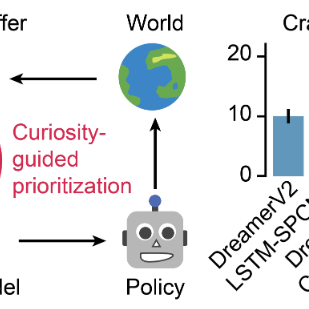
Isaac Kauvar
@ikauvar
Followers
631
Following
213
Media
19
Statuses
139
mapping neural circuits of intelligence @anthropicAI prev: phd in cross-species neuroscience (human, mouse, fish) @stanford https://t.co/1A57jSXrFe
California, USA
Joined February 2018
Emotions are core to the human experience 😆😮🙂😊☹️😠😳😑. But how do they arise? Our brain-wide ⚡recordings in humans and mice reveal some answers @ScienceMagazine. A big team effort and debut paper from @Stanford's new Human Neural Circuitry program.
5
41
156
RT @AnthropicAI: Join Anthropic interpretability researchers @thebasepoint, @mlpowered, and @Jack_W_Lindsey as they discuss looking into th….
0
189
0
RT @MichaelOkun: Piano pedals of the brain? New paper in Science this week teaches us how how emotion echoes across species. A groundbreaki….
0
10
0
Thank you @StanfordMed for the detailed reporting on our work. And great title too! How we used an opthalmologist's tool to study the neural mechanisms of emotion.
med.stanford.edu
Humans and mice share persistent brain-activity patterns in response to adverse sensory experience, Stanford scientists find, opening a window to our emotions and, perhaps, neuropsychiatric disorders.
1
5
33
Great thread highlighting our study's findings, by co-lead author @liutony66.
💥Emotions are central to the human experience 😠😳😃☺️😔😕😮🙂.Our Human Neural Circuitry team just took a step towards understanding how they arise–using brain-wide electrical ⚡recordings in humans and mice @ScienceMagazine .Read on for more… 1/n
0
0
3
Thank you @NPR @NPRHealth @nprscience for a beautiful piece about our work studying the neural basis of emotion. Your creativity in applying the piano analogy was 🎯 .
npr.org
A study offers a glimpse of how the brain turns experience into emotion. In mice and humans, puffs of air to the eye caused persistent changes in brain activity, suggesting an emotional response.
1
0
7
Thank you for the insightful summary and perspective on our work @ScienceMagazine @NadineGogolla @stoyo_k ."A wave of emotion"
0
0
3
It was amazing working on this with Ethan Richman, @liutony66 @KarlDeisseroth @CRodriguezMDPhD @VivekBuchMD, Paul Nuyujukian, @SamVesuna @chibyanada and many others. And we are very grateful for the incredible contributions of the participants who volunteered to be in the study.
0
2
12
We hypothesize that aspects of the etiology and treatment of certain neuropsychiatric disorders may be governed by alteration of such persistence-related phenomena.
2
1
10
By analogy to a piano's sustain pedal, emotional responses to sensory stimuli require the brain's "sustain pedal" to be activated, allowing signals to persist and accumulate.
1
2
14
One high level takeaway is that emergence of emotional responses in mammals seems to rely on the brain's capacity to sustain persistent activity dynamics. By pharmacologically disrupting this ability of the brain, we blunt emotional responses in both humans and mice.
2
2
11
RT @_rockt: I am really excited to reveal what @GoogleDeepMind's Open Endedness Team has been up to 🚀. We introduce Genie 🧞, a foundation….
0
552
0
RT @nickhaber: @ikauvar and @chrisrdoyle will present “Neurobehavior of exploring AI agents” (, and @chrisrdoyle wi….
0
2
0
Very excited about Ethan Richman’s study that provides deep insight into competition between homeostatic needs! The work has it all — a new behavioral assay, brain-wide Neuropixels + optogenetics, and a new framework for understanding brain state dynamics.
Excited to see Ethan Richman's tour de force study of homeostatic drive competition come out! Brain-wide Neuropixels + exciting new approaches for modeling internal states. With Liqun Luo and .@KarlDeisseroth.
1
5
43
RT @realJessyLin: How can agents understand the world from diverse language? 🌎. Excited to introduce Dynalang, an agent that learns to unde….
0
115
0
RT @CamilleTestard: *THRILLED* to share our latest work with @seb_trem & co in @MichaelLouisPl1 ’s lab!. Primates maintain long-term bonds….
biorxiv.org
Our understanding of the neurobiology of primate behavior largely derives from artificial tasks in highly-controlled laboratory settings, overlooking most natural behaviors primate brains evolved to...
0
32
0
RT @tylerraye: how should we interpret neuroscientific evidence across species?. our (adversarial!) collaboration is out in @eLife 🥳🪩✨we hi….
elifesciences.org
A 'stimulus-computable' modeling approach resolves apparent inconsistencies between human and monkey lesion data, implicating perirhinal cortex in visual object perception.
0
17
0
RT @StanfordHAI: Learning through curiosity: Scholars developed a novel training method called Curious Replay, which programs AI agents to….
0
15
0
Co-led by @chrisrdoyle , a fantastic team effort with Linqi Zhou, and @nickhaber .With thanks to @StanfordHAI @StanfordBrain . Website: ICML 2023 Paper:
sites.google.com
Abstract Agents must be able to adapt quickly as an environment changes. We find that existing model-based reinforcement learning agents are unable to do this well, in part because of how they use...
0
0
19












